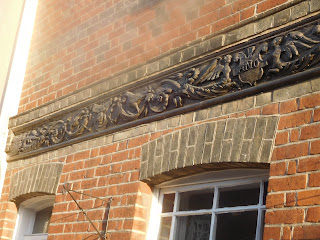1871: The Collapse of the Silk Industry
1871: the year that "Middlemarch" is published in serial form. Queen Victoria has been a widow for ten years and is still in full mourning. We left Coggeshall in 1861 as a flourishing industrial town, bursting at the seams with lodgers working in the silk mills, and with a new, albeit smelly, industry being developed in West Street. What could possibly go wrong? To answer that we need to go back to 1860 when a treaty was signed between Britain and France. This was the Cobden/Chevalier treaty which abolished some of the tariffs on goods traded between the two countries. Specifically, wine, brandy and silk from France and coal, iron and industrial goods from Britain. Just those two lists tell a complete story, (or poem by John Masefield). Trade in these items doubled in the following years. One of the aims of such a treaty may have been to bind the two nations together, making conflict less likely, but in Coggeshall it had a more immediate effect on the people of East Street, as we shall see.
Out of 284 inhabitants in East Street, 111 were sixteen or under. For the first time, three people were from other European countries: Two sisters from Belgium and a watch and clock-maker from Germany. A small boarding and day school had been set up, with some of the pupils possibly boarding at Caxton House, the premises of the Post Office and Printers. Twenty-two women and girls were employed as servants, four as "Daily Servants", presumably living at home. Ten people were employed as Lace-makers.
The big change
In 1861 there were twenty-nine people employed as weavers or throwsters living in East Street. In 1871 there were only seven weavers and no throwsters at all. Curiously, only two of the seven had lived in East Street in 1861. Silk was still being produced in Coggeshall, and the industry continues in Sudbury to this day, but that is a dramatic change. No doubt it had become impossible to compete with French imports after the Free Trade Act. One young lady was working at the "Crape Factory". In the later years of Victoria's reign there was a huge demand for black crape as part of formal mourning, about which society had strict rules.
Factory Workers
Three people were listed as Gelatine workers and a further six as factory workers. It is possible that some of these were still employed in making silk, but equally could have been at the Isinglass factory. The manager of that factory, Henry Foster, lived in East Street with his wife and four children, one of whom, Henry, aged 21, was a leather cutter, perhaps working at the tannery on the same site.
A friend has alerted me to the phrase "isinglass curtains" from "Oklahoma." This is a use I would never have predicted: curtains made of sheets of gelatine, flexible enough to roll up and yet opaque, used in bad weather on surreys and other horse-drawn vehicles. Apparently vinyl curtains are still referred to as "Isinglass" as they serve the same purpose. Who knew?
#silk


Chilling to read of the unintended consequences of the FTA - I imagine it was meant to beca win-win : our industrial machines, your wine. The Coggeshall silk trade was collateral damage, it seems.
ReplyDeleteAs I understand it, lots of resources were being invested to prepare for war with France and the FTA was proposed as a peaceful alternative. Not a bad plan in itself.
ReplyDelete